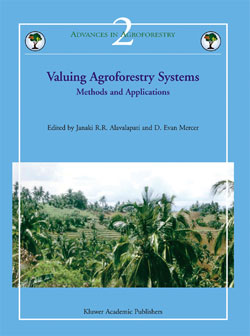The book Valuing Agroforestry Systems: Methods and Applications, edited by J.R.R. Alavalapati and D. Evan Mercer (Kluwer Academic Publishers, 2004) provides an excellent contribution to the literature for systems valuation, an area in agroforestry studies that has lagged behind while the ecological and biophysical aspects took off, as pointed out by the editors. It is a valuable reference for students, researchers, and professionals and policy makers in rural development, agroforestry, and related natural resource areas.
The book contains a range of papers that cover not only an array of economic methodologies for agroforestry system valuation, but also approaches for institutional analyses of these systems. Significantly, it takes a global (yet individualized system) perspective, drawing examples from case studies on all five continents and from both tropical and temperate systems.

Valuing Agroforestry Systems is organized into five sections, with each section having two to five papers, in recognition that economic and policy considerations permeate all aspects of agroforestry. A concluding summary chapter discusses the present status of economic and policy research and modeling in agroforestry, and proceeds to define the gaps that needed to be addressed by future research in this area.
Section 2, Economic Analyses, has five papers that offer several approaches to determining the profitability of agroforestry systems, possibly a reflection of the comparatively larger number of studies done in this area. The emphasis of the papers in this section is on determination of the profitability of agroforestry systems using different approaches, i.e., the enterprise model, Land Expectation Value (LEV), policy analysis matrix (PAM), production function, and portfolio model to analyze risk. Case studies using these different methods are documented from Africa, USA, Pacific Islands, India and the UK.
Section 3, Environmental Economic Analyses, presents case studies to illustrate several environmental economic methodologies that examine both market and the non-market benefits (also known as externalities) of agroforestry systems. For example, the cost of the mitigation potential of agroforestry systems for carbon sequestration is estimated, using a case study of farmers participating in a carbon trading program in Mexico. The use of dynamic optimization to evaluate the externalities associated with an agroforestry practice (e.g. dryland salinity) is documented in Australia. The econometric method is used to evaluate environmental services (particularly soil conservation and forest conservation) from agroforestry in Indonesia. The final paper in this section illustrates another environmental valuation methodology, the contingent valuation method (CVM), to assess the cost of adopting silvopasture for cattle ranchers in Florida.
Section 4, Household Constraints and Agroforestry Adoption, look at the issue of adoption and the factors affecting the adoption decision. Using a 5-year linear programming (LP) model, the first paper examines an economic assessment of household constraints to the adoption of improved fallow in Zimbabwe. The next chapter applies an integrated LP and econometric model in a 3-step process to evaluate factors that influence the adoption of improved fallows in Malawi in Southern Africa. The final paper in this section provides another perspective by describing an alternative econometric-based method for ex-ante analysis of agroforestry system adoption potential. In particular, an attribute-based choice experiment (ACE), a subset of conjoin analysis, is applied to develop information for improving the adoption potential of agroforestry projects in southeast Mexico.
Section 5, Macroeconomic and Institutional Analyses, focuses on the role of agroforestry systems in rural development and institutional arrangements required to further adoption. Using state-of-the-art econometric time series techniques, the effect of agroforestry on agricultural productivity, and the spatial and temporal relationships between trees and annual crops in Northern China are estimated. The next chapter offers an analysis framework as a tool for organizing institutional information about agroforestry systems. The authors present an overview of agroforestry systems and institutions to provide the reader with contextual insights into the development of the framework. Then they identify the framework�s major attributes and demonstrate how these attributes can be used to diagnose and understand problems related to agroforestry.
In the concluding chapter, the editors Evan Mercer and Janaki Alavalapati provide an excellent summary of the major points and issues raised by the contributing authors. They describe the status of economic research and modeling in agroforestry, and identify gaps for further research in this area. This chapter encapsulates the book�s contents and should be of interest to readers who wish to have a bird�s eye view of the diversity of methodologies contained therein. The editors summarize the main results and discuss the status of economic research and modeling in agroforestry.
Click here for a more detailed review by Lita Rule of individual chapters in Valuing Agroforestry Systems, see . To purchase copies, visit the AFTA Bookshop (AFTA members should log in first to obtain the discounted price).
By Lita C. Rule
Iowa State University



